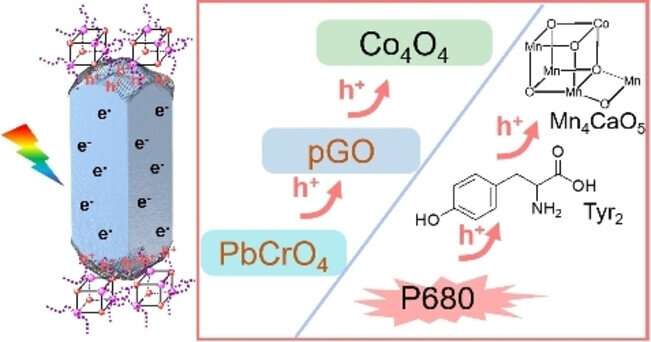This article has been reviewed according to Science X's editorial process and policies. Editors have highlighted the following attributes while ensuring the content's credibility:
fact-checked
peer-reviewed publication
trusted source
proofread
Researchers develop interfacial charge modification strategy to enhance photocatalytic water oxidation

Water oxidation reaction involves a four-electron and four-proton transfer process, which requires an uphill energy transformation and limits the efficiency of the overall photocatalytic water splitting reaction.
Although loading appropriate water oxidation cocatalysts can enhance the performance of water oxidation reactions, the interfacial barrier between the semiconductor and the water oxidation cocatalyst can impede the transfer and utilization of photogenerated charges.
Recently, a research team led by Profs. Li Can and Li Rengui from the Dalian Institute of Chemical Physics (DICP) of the Chinese Academy of Sciences (CAS) has developed a strategy to controllably assemble a charge-transfer mediator in photocatalysis, which could increase surface charge-transfer efficiency and photocatalytic water oxidation activity. The study was published in Angewandte Chemie International Edition on March 23.
Inspired by natural photosynthesis, the researchers employed partially oxidized graphene (pGO) as a charge-transferring mediator on the hole-accumulating facets of lead chromate (PbCrO4) photocatalyst. The pGO could be selectively assembled on the hole-accumulating facets of PbCrO4 by an ultrasonic deposition process, and cobalt-complex Co4O4 molecules could be anchored on the pGO as water oxidation cocatalyst.
Based on techniques such as surface photovoltage spectroscopy, they confirmed that introducing the pGO charge transfer mediator between the hole-accumulation facets of PbCrO4 and Co4O4 molecules could effectively suppress charge recombination at the interface, thus prolonging the lifetime of photogenerated charges and enhancing photocatalytic water oxidation performance.
"The strategy of rationally assembling charge transfer mediator provides a feasible way for accelerating charge transfer and charge utilization in semiconductor photocatalysis," said Prof. Li Rengui.
More information: Wenchao Jiang et al, Graphene Mediates Charge Transfer between Lead Chromate and a Cobalt Cubane Cocatalyst for Photocatalytic Water Oxidation, Angewandte Chemie International Edition (2023). DOI: 10.1002/anie.202302575
Journal information: Angewandte Chemie International Edition
Provided by Chinese Academy of Sciences





















